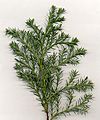Chamaecyparis pisifera
| Chamaecyparis pisifera | |
|---|---|

| |
| Chamaecyparis pisifera Morton Arboretum acc. 745-27*4 | |
| Scientific classification | |
| Kingdom: | Plantae |
| Clade: | Tracheophytes |
| Clade: | Gymnospermae |
| Division: | Pinophyta |
| Class: | Pinopsida |
| Order: | Cupressales
|
| Family: | Cupressaceae |
| Genus: | Chamaecyparis |
| Species: | C. pisifera
|
| Binomial name | |
| Chamaecyparis pisifera (
Endl. | |
Chamaecyparis pisifera (Sawara cypress or Sawara
Description
It is a slow-growing
Related species
A related cypress found on Taiwan, Chamaecyparis formosensis (Formosan cypress), differs in longer ovoid cones 6–10 mm long with 10–16 scales.[2] The extinct Eocene species Chamaecyparis eureka, known from fossils found on Axel Heiberg Island in Canada, is noted to be very similar to C. pisifera.[3]
Name
The Latin specific epithet pisifera, “pea-bearing”, refers to the small round green cones.[4]
Uses
Timber
It is grown for its timber in Japan, where it is used as a material for building palaces, temples, shrines and baths, and making coffins, though less valued than the timber of C. obtusa. The wood is lemon-scented and light-colored with a rich, straight grain, and is rot resistant.[5]
Ornamental
It is also a popular ornamental tree in
In cultivation in the UK the following have gained the Royal Horticultural Society’s Award of Garden Merit[6] (confirmed 2017):[7]
- ‘Boulevard’:[8] 8 m (26 ft), blue-green foliage
- ‘Filifera Aurea’:[9] rounded, needle-like golden foliage, to 12 m (39 ft)
- ‘Plumosa Compressa’:[10] dwarf to 90 cm (35 in), soft mossy foliage on young plants
- ‘Sungold’:[11] rounded shrub to 3 m (9.8 ft) tall and wide, with needle-like lime green foliage
-
Grove of 80-year-old trees
-
Foliage and cones
-
Central trunk of a tree
-
Bark
-
Path in the Togakushi Shrine lined with C. pisifera
-
Bonsai example
-
Foliage of the juvenile cultivar 'Boulevard', with soft feathery needle-like leaves
-
Cultivar 'Golden Charm'
-
Cultivar 'Filifera aurea'
-
Leaves of the Filifera aurea
-
Cultivar 'Sungold'
References
- ^ . Retrieved 11 November 2021.
- ^ ISBN 1-84246-068-4
- doi:10.1139/B03-007.
- ISBN 978-1845337315.
- ^ a b Dallimore, W., & Jackson, A. B. (1966). A Handbook of Coniferae and Ginkgoaceae 4th ed. Arnold.
- ^ "RHS Plantfinder -".
{{cite web}}: Missing or empty|url=(help) - ^ "AGM Plants - Ornamental" (PDF). Royal Horticultural Society. July 2017. p. 16. Retrieved 24 January 2018.
- ^ "RHS Plantfinder - Chamaecyparis pisifera 'Boulevard'". Retrieved 30 January 2018.
- ^ "RHS Plantfinder - Chamaecyparis pisifera 'Filifera Aurea'". Retrieved 30 January 2018.
- ^ "RHS Plantfinder - Chamaecyparis pisifera 'Plumosa Compressa'". Retrieved 30 January 2018.
- ^ "RHS Plantfinder - Chamaecyparis pisifera 'Sungold'". Retrieved 30 January 2018.












